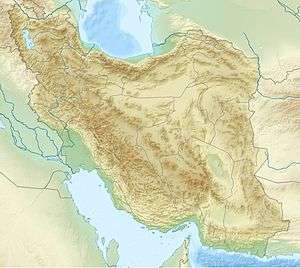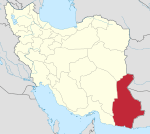Hamun-e Helmand
| Hāmūn-e Helmand | |
|---|---|
| Location | southeast Iran |
| Coordinates | 30°50′N 61°40′E / 30.833°N 61.667°ECoordinates: 30°50′N 61°40′E / 30.833°N 61.667°E |
| Primary inflows | Helmand River |
| Basin countries | Afghanistan / Iran |
| Surface area |
~ 2,000-4,000 km2 (~ 800-1,500 mi2) depending on a Helmland river flood[1] (including Hāmūn-e Sabari and Hāmūn-e Puzak) |
Hāmūn-e Helmand (also known as Hāmūn-e Hīrmand, “Lake Hāmūn”, Hamoun Oasis, Persian: دریاچه هامون Daryācheh-ye Hāmūn or Daryācheh-ye Sīstān (“Lake Sīstān”)) is a shallow, marshy, lake (or lagoon) or hāmūn located in the Sistan region of eastern Iran and western Afghanistan. It is fed by the Helmand River, which starts in the Hindu Kush mountains in Afghanistan. Together with two sibling shallow lakes, Hāmūn-e Sabari and Hāmūn-e Puzak, which extend into the Lash wa Juwayn District of Farah Province in Afghanistan, it forms the extended wetlands of the endorheic Sīstān Basin which straddles a large border region in southeastern Iran and southwestern Afghanistan.
Lake Hāmūn is fed primarily by water catchments on the Afghani side, including the Harut River. It is in the Sistan region and it is in the Lash wa Juvayn District of the Farah Province of Afghanistan. The Harut River flows into the lake on the Afghanistan side of the border.In 1976, when rivers in Afghanistan were flowing regularly, the amount of water in the lake was relatively high. Between 1999 and 2001, however, the lake all but dried up and disappeared, as can be seen in the 2001 satellite image.
When droughts occur in Afghanistan, or the water in watersheds that support Lake Hāmūn is drawn down by other natural or human-induced reasons, the end result is a dry lake bed in Iran. In addition, when the lake is dry, seasonal winds blow fine sands off the exposed lake bed. The sand is swirled into huge dunes that may cover a hundred or more fishing villages along the former lake shore. Wildlife around the lake is negatively impacted and fisheries are brought to a halt. Changes in water policies and substantial rains in the region hope to effect a return of much of the water in Lake Hamoun by 2003.[3]
In 1975 the hāmūn, together with Hāmūn-e Sabari, was designated a Ramsar site.[4]

See also
Notes
References
- Kobori, Iwao; Glantz, Michael H., eds. (1998), "Central Eurasian water crisis: Caspian, Aral, and Dead Seas", Part III: The Caspian Sea, United Nations University Press, ISBN 92-808-0925-3, retrieved 31 August 2010
|chapter=ignored (help) - Partov, Hassan (1998), Lake Hamoun, United Nations Environment Programme (UNEP): DEWA/GRID Europe, retrieved 24 September 2010
- Weier, John (3 December 2002), From Wetland to Wasteland; Destruction of the Hamoun Oasis, NASA Earth Observatory, retrieved 24 September 2010 External link in
|publisher=(help) - UNEP (May 2006), History of Environmental Change in the Sistan Basin - Based on Satellite Image Analysis: 1976–2005 (PDF), Geneva: United Nations Environment Programme (UNEP) Post-Conflict Branch, retrieved 2007-07-20
External links
| Wikimedia Commons has media related to Lake Hāmūn. |

